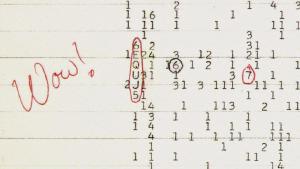Post
Wow!
24 May 2013
 Big Ear
Big EarThe Big Ear radio telescope was built in 1963 to survey the sky for extragalactic radio sources. It is a type of radio telescope that uses the rotation of the Earth to make observations. The receiver of the radio telescope can be moved north or south, but to view things east and west you have to wait for the Earth to rotate in the right direction. This type of telescope is perfect for making sky surveys, because you can point it in a particular declination (the sky version of latitude), and then let the Earth’s motion move you through a full circle of sky over the course of a day.
After the sky survey was completed in 1971, and funding for the telescope ended soon after. In 1973 it was funded by the SETI project to search for possible signals of extraterrestrial intelligence. Then in 1977 the telescope observed a very unusual signal. It is now known as the Wow! signal, and you can see the original printout of it in the figure above. The numbers represent the strength of the signal compared to the average background radio noise. The scale goes from 1 to 9, then A to Z. The U in the figure means at its most intense it was 30 times stronger than the background noise.
The information we can gather from this signal is fairly limited due to the way Big Ear gathered data. It had two “feed horns” that pointed at slightly different directions. These funneled the radio signals into a detector. Given the way the detector processed these signals, it was only possible to determine if a signal was detected by one or both of them. The detector measured the signals once a second at 50 different frequencies. Every 10 seconds they were averaged to give the intensity, and the result was printed as seen in the figure below. This might seem pretty crude, but it was one of the earliest automated astronomical systems. Big Ear was designed so it could be turned on and left to collect large amounts of data that could be analyzed later.
Still, even with those limitations, the Wow! signal has some very interesting properties. As the figure shows, the signal starts off quiet, reaches a maximum in the middle, then dies down again. It lasts for about 72 seconds, which is exactly how long a particular patch of sky would be in focus due to the rotation of the Earth. This means the signal appeared to move with the sky, so it wasn’t likely to be of terrestrial origin. When you look at the raw data, it seems the actual intensity of the signal was constant.
Another interesting property was that it was only detected by one of the feed horns. This means it came from a narrow region of the sky, rather than a wide area. It was also only detected at one frequency, about 1420 MHz (or a wavelength of 21 cm). This frequency happens to be known as the hydrogen line because it is a frequency produced by atomic hydrogen. It is also a frequency that isn’t easily blocked by gas and dust in the galaxy, which makes it the perfect frequency for sending signals over stellar distances.
So it seems the Wow! signal was a non-terrestrial, very intense signal at the 21 cm hydrogen line that lasted for at least 72 seconds. The Wow! signal originated from a direction in the constellation Sagittarius. There is a main sequence star 120 light years away in that general direction, known as Tau Sagittarii, but there’s nothing particularly unusual about that star. There’s no clear source that could have caused such a signal.
So what was it? The short answer is we don’t know. The signal has all the properties we would expect from an extraterrestrial intelligence. High intensity, specific frequency, long lasting. It is exactly the type of signal SETI was looking for. But since Big Ear only made one measurement a second we have no way of determining if it had any detailed structure. It might have just been an intense energy burst. As far as we know, such a burst should have been detected at multiple frequencies, but who knows. It might also have been a terrestrial signal that reflected off something in space, although 1420 MHz is a restricted frequency, so nothing on Earth should have been broadcasting at that frequency.
But the signal was never observed again. Multiple observations have been made of that region of space over the years, but no hint of the signal has ever been found. If it really were an intentional signal from an extraterrestrial intelligence, then one would expect it to be repeated multiple times. Since it has never been repeated it is most likely that it was a reflected signal from Earth (say, from a military source) or some kind of radio interference. Without further observations it’s really a big mystery.
For some astronomical observations, all you can say is Wow!